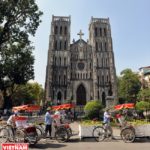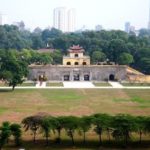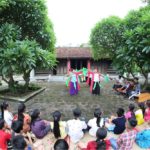The Hanoi Tourism Department is planning to develop two tourist routes called “Explore the Heritage Road in the South of Thang Long” to promote the heritage and handicraft villages in the capital city. This initiative aims to create new tourism destinations and products for the city.
Along the Central Hanoi – Thanh Tri – Thuong Tin – Phu Xuyen route, visitors will have the opportunity to visit Ngau Village in Thanh Tri District, Phuc Am Village in Thuong Tin District, and Cuu Village in Phu Xuyen District.

Ngau Village is renowned for its winemaking and the splendid architecture of Ngau Pagoda. Visitors can enjoy the scenic beauty and ancient monuments, as well as explore the local wine producers and the unique products of the region under the OCOP (One Commune One Product) program.
Phuc Am Village is famous for its votive offering tradition. As visitors enter the village, they can immediately sense the bustling and vibrant atmosphere of the upcoming Tet (Lunar New Year) celebration. On the other hand, Cuu Village is an old village with numerous European-style houses nestled amidst a tranquil and rustic setting.
The Hanoi Central – Thanh Oai – Ung Hoa – My Duc tourist route includes visits to Noi Binh Da communal house in Thanh Oai District, Quang Phu Cau incense stick handicraft village in Ung Hoa District, and the silk and lotus silk handicraft workshops in My Duc District.

During this journey, visitors will have the opportunity to learn about the architectural and cultural significance of the temple dedicated to the national ancestor, Lac Long Quan. The communal house stands out with its bas-relief depicting the boat race festival on the Do Dong River, which Lac Long Quan, the founder of the Vietnamese nation, attended along with the Lac Viet marquis and generals. This bas-relief was recognized as a national treasure by the Prime Minister in 2015.
The Quang Phu Cau incense stick craft village is a popular destination for both domestic and international tourists. Not only will visitors be captivated by the stunning bouquets of incense sticks resembling colorful flowers basking in the sunlight, but they will also be enchanted by the delightful fragrance exuding from the village’s handicraft workshops.
At My Duc Silk Village, visitors can immerse themselves in mulberry picking, silkworm feeding, spinning, and the intricate art of lotus silk production.
According to Phan Huy Cuong, Head of the Planning Division at the Hanoi Department of Tourism, although these destinations have started to gain recognition among tourists, there is still a lack of professionalism in tourism activities, poor infrastructure, unsynchronized services, and an underdeveloped human resource base for tourism. Hence, the tourism potential of these areas has yet to be fully tapped, and there are several constraints in attracting tourists.
Cuong mentioned that the city will prioritize support and guidance for the management units of heritage sites and cultural relics, as well as the development of new tourist attractions and experiential cultural products related to night tourism.
Following the survey, Phung Quang Thang, Chairman of the Hanoi Travel Association, expressed that these routes will lay the groundwork for travel agencies to create new tour itineraries that connect various localities.
Travel agencies believe that for these new tours to succeed, local authorities need to enhance tourism infrastructure, including improving roads and parking facilities, promoting souvenir sales and local products, and providing training to enhance the communication skills of the local populace.
Hanoi Cathedral
Built in the 1780s, Hanoi Cathedral is considered a witness to great changes of the capital of Vietnam for three centuries. Today, it is not only the centre for catholic activities, but also a popular tourist site in the land of a thousand-year-old culture.








